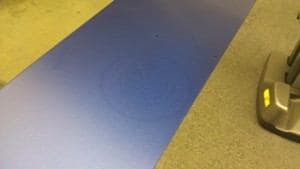
-----
Type II anodize, oil marks show through
June 28, 2011
As sheet metal is lifted on and off the laser bed, suction cups leave marks behind. These marks are oily and can be wiped clean. This part was lightly sanded/grained and the oil marks were present, and then they were run through type II anodize with the assumption that the oil would be cleaned and etched off.
Apparently not - should we be expecting the anodize clean and etch process to remove this?

Quality Assurance - Everett, Washington, USA
Two possibilities. (1) The anodizer's not-etch soak cleaner is either etching before the oil comes off, OR it is leaving a silicate film that subsequently interferes with the pattern of the etch. (2) the oil is slightly etching and the anodizing is magnifying the etch. Either way should be easy to determine.

Robert H Probert
Robert H Probert Technical Services
Garner, North Carolina

June 30, 2011
July 1, 2011
Rule out oil (or rubber suction cup residue) pre etching on its own. The oil markings are easily wiped off without a trace, almost like wiping off dust - that easy. I am not going to be able to run tests on this or anything, but I wonder had the markings been left untouched on bare metal if they would have cleaned/etched off? What we had were markings that were half sanded off half embedded into the grain.... like stuck on so to speak. these parts were lightly sanded/grained. Usually parts get a moderate to heavy (heavy enough) graining that all these markings are removed completely.. or smeared around maybe, but you can't see them.
Either of the other two possibilities you suggest mean the same thing to the me, I can't let these parts go out like this. It would have been nice if the Anodizer would have stopped the parts after the first clean stage and brought it to our attention, but I probably would have just said its oil that wipes right off..?!
lesson learned... Thank you for the input.
Sheet Metal Fab - Everett Washington USA
OK, I'll try again. Was the sanding media used on any other metal OR was it very strictly (including the night shift) designated "aluminum only"? And, was the sanding randomly manual, or automated to be perfectly uniform?

Robert H Probert
Robert H Probert Technical Services
Garner, North Carolina

July 5, 2011
July 6, 2011
"OK, I'll try again. Was the sanding media used on any other metal"..... no.
"OR was it very strictly (including the night shift) designated "aluminum only"? ..... yes
"And, was the sanding randomly manual, or automated to be perfectly uniform"..... timesaved automatic.
I have to think it is rubber particles embedded in the grain. I would have thought that the particles would have been smeared more than they were though, from the timesave action. The rubber suction cup marks can't be pre-etching, because all of our sheets would have suction cup marks, or if they are pre-etching we don't notice because we always timesave the marks off, or smear them around enough to not notice them.
Sheet Metal Fab - Everett Washington USA
July 7, 2011
Many many years ago, I experienced a similar problem with a customer who sent us his parts wrapped in bubble wrap. There was something in the bubble wrap that penetrated the aluminum, that would not come off during our normal pretreatment..and hence, showed up after anodizing. Little bubble wrap marks all over the parts. The end result was similar to the picture I see, but of course the problem was much worse due to the amount of "bubbles" that touched the part.
You say that the marks are "oily and can be wiped clean"..but really, how closely have you examined the parts to make sure they truly are indeed "clean". If you're talking about a quick visual check from a couple feet away, then you can't be sure they really are clean. You'd have to look at this microscopically to verify the cleanliness, especially if we're talking about potentially impregnating something into the grains of the aluminum.
If it's strictly oil, then I'd say you're correct, and that it should come off during the anodizing pretreatment...but if perhaps your suction cups may be leaving a silicone (as in silicone rubber) residue behind........ most normal pretreatments will not remove that successfully.
Also, you didn't mention if this is a brand new problem you're experiencing when you've had success in the past? If indeed that is so (you've have quality parts in the past using the same process) then you must start from square one on your end to see what has changed...and require your anodizer to do the same.
Hard to say if your anodizer should have caught this after the pretreatment...I know that we didn't when we had the "bubble wrap" issue.

Marc Green
anodizer - Boise, Idaho
July 11, 2011
I do believe that it is the silicone rubber particles that are being embedded into the grain acting as a anodize mask.
It makes sense that they could be wiped off easy when fresh in the oil, but not wiped off when ground into the grain. The oil probably washes off, the rubber silicone particles remain embedded.
Considering the robust mechanical action of the timesave process it is hard not to completely remove the suction cups marks, or completely smear them around till they visually dissipate. That is what usually happens, complete removal of suction cup marks. We probably couldn't purposefully replicate the light grain with suction cup shadow marks if we tried.
Sheet Metal Fab - Everett Washington USA
Q, A, or Comment on THIS thread -or- Start a NEW Thread